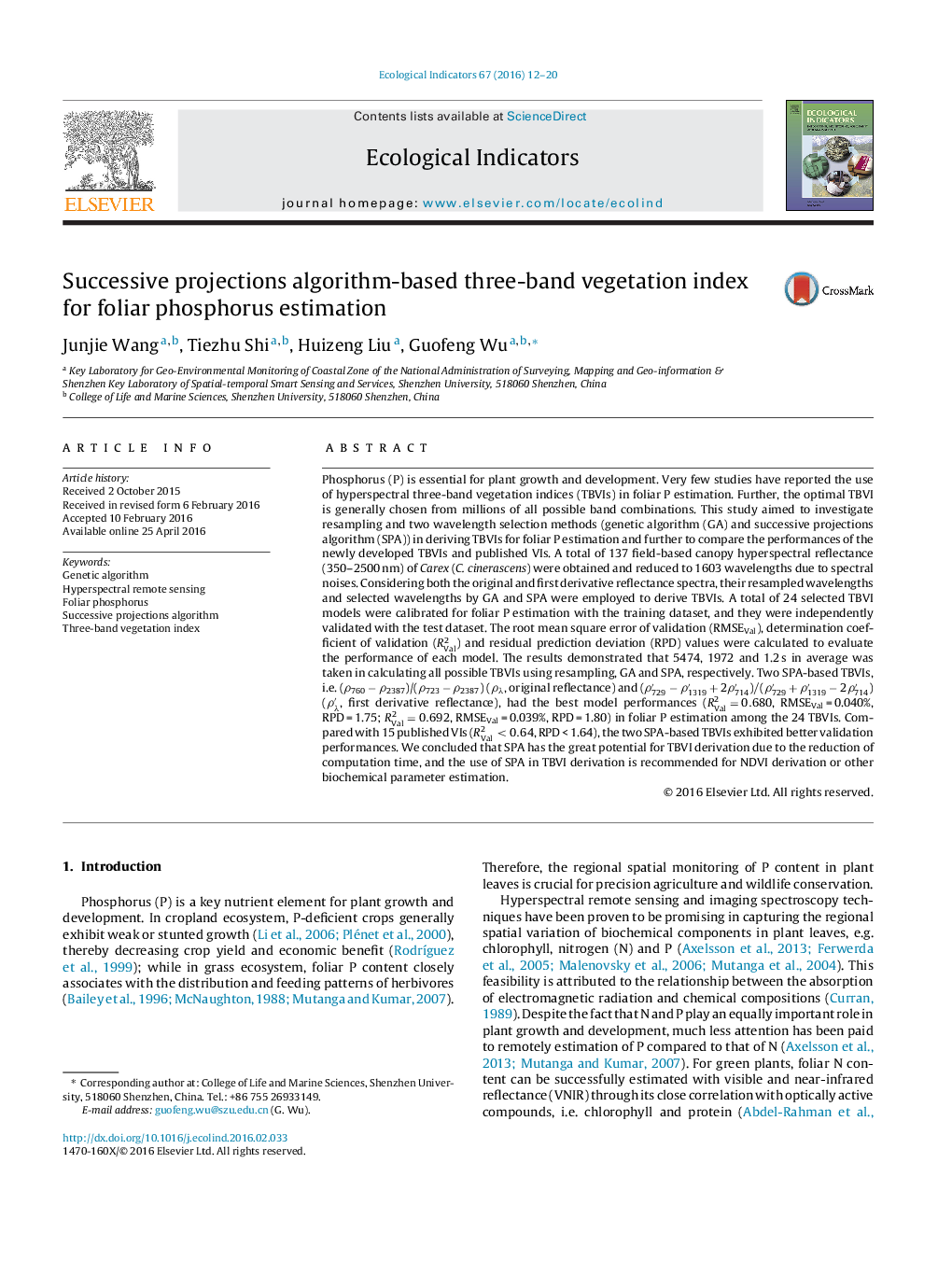| کد مقاله | کد نشریه | سال انتشار | مقاله انگلیسی | نسخه تمام متن |
|---|---|---|---|---|
| 4372849 | 1617135 | 2016 | 9 صفحه PDF | دانلود رایگان |
عنوان انگلیسی مقاله ISI
Successive projections algorithm-based three-band vegetation index for foliar phosphorus estimation
ترجمه فارسی عنوان
شاخص تخمینی سه باند مبتنی بر الگوریتم پیش بینی تخمینی فسفر برگ
دانلود مقاله + سفارش ترجمه
دانلود مقاله ISI انگلیسی
رایگان برای ایرانیان
کلمات کلیدی
الگوریتم ژنتیک، سنجش از دور سنجی، فسفر برگ الگوریتم پیش بینی های متوالی، شاخص پوشش گیاهی سه باند،
موضوعات مرتبط
علوم زیستی و بیوفناوری
علوم کشاورزی و بیولوژیک
بوم شناسی، تکامل، رفتار و سامانه شناسی
چکیده انگلیسی
Phosphorus (P) is essential for plant growth and development. Very few studies have reported the use of hyperspectral three-band vegetation indices (TBVIs) in foliar P estimation. Further, the optimal TBVI is generally chosen from millions of all possible band combinations. This study aimed to investigate resampling and two wavelength selection methods (genetic algorithm (GA) and successive projections algorithm (SPA)) in deriving TBVIs for foliar P estimation and further to compare the performances of the newly developed TBVIs and published VIs. A total of 137 field-based canopy hyperspectral reflectance (350-2500 nm) of Carex (C. cinerascens) were obtained and reduced to 1603 wavelengths due to spectral noises. Considering both the original and first derivative reflectance spectra, their resampled wavelengths and selected wavelengths by GA and SPA were employed to derive TBVIs. A total of 24 selected TBVI models were calibrated for foliar P estimation with the training dataset, and they were independently validated with the test dataset. The root mean square error of validation (RMSEVal), determination coefficient of validation (RVal2) and residual prediction deviation (RPD) values were calculated to evaluate the performance of each model. The results demonstrated that 5474, 1972 and 1.2 s in average was taken in calculating all possible TBVIs using resampling, GA and SPA, respectively. Two SPA-based TBVIs, i.e. (Ï760 â Ï2387)/(Ï723 â Ï2387) (Ïλ, original reflectance) and (Ïâ²729âÏâ²1319+2Ïâ²714)/(Ïâ²729+Ïâ²1319â2Ïâ²714) (Ïâ²Î», first derivative reflectance), had the best model performances (RVal2=0.680, RMSEVal = 0.040%, RPD = 1.75; RVal2=0.692, RMSEVal = 0.039%, RPD = 1.80) in foliar P estimation among the 24 TBVIs. Compared with 15 published VIs (RVal2<0.64, RPD < 1.64), the two SPA-based TBVIs exhibited better validation performances. We concluded that SPA has the great potential for TBVI derivation due to the reduction of computation time, and the use of SPA in TBVI derivation is recommended for NDVI derivation or other biochemical parameter estimation.
ناشر
Database: Elsevier - ScienceDirect (ساینس دایرکت)
Journal: Ecological Indicators - Volume 67, August 2016, Pages 12-20
Journal: Ecological Indicators - Volume 67, August 2016, Pages 12-20
نویسندگان
Junjie Wang, Tiezhu Shi, Huizeng Liu, Guofeng Wu,
